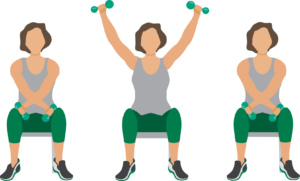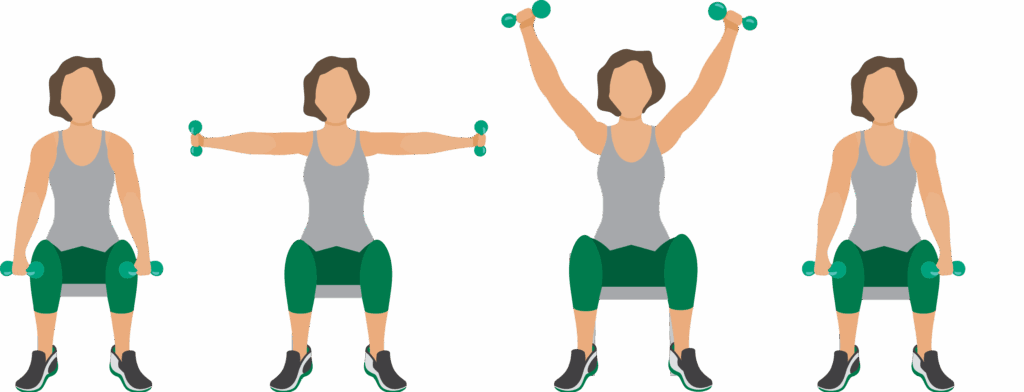Endurance – Upper Limb
Although most research studies have concentrated on lower limb exercise training, the upper limbs should not be neglected as the arms are frequently used in everyday tasks.
Some studies have examined supported arm training (arm cranking), however arm cranks are not readily accessible and arm cranking is not a very functional activity. A Cochrane review of upper limb training in COPD has demonstrated that unsupported arm exercises had a large effect on unsupported arm endurance capacity.10 Consequently, a pulmonary rehabilitation program should include unsupported arm exercises with or without added weights (depending on patient’s degree of dyspnoea and/or physical comorbidities).
Examples of unsupported arm exercises are shown below. Arm exercises should not cause significant discomfort to the shoulders or neck. Check with the patient about any shoulder or neck problems before commencing arm training and modify the range of movement if necessary. Cease arm exercises if shoulder or neck discomfort or pain persists.
Patients with ILD can also benefit from the inclusion of unsupported arm exercises.
Upper Limb Endurance Exercises
(low weight and high repetition)
The exercises below were adopted from22:
Ellis, B. P. T. & Ries, A. L., 1991. Upper Extremity Exercise Training in Pulmonary Rehabilitaiton. Journal of Cardiopulmonary Rehabiliation and Prevention, July, 11(4), pp. 227-231.
Exercise 1
To be performed whilst seated in a chair with back support.
Sit with your feet flat on the floor, and the small of your back pressed back into the chair.
Elbows must not be locked.
Arms crossed in the lap, elbows straight and palms facing down.
Lift arms up, out and apart until they are fully extended above the head with palms
facing backwards.
Return to starting position.
Exercise 2
To be performed whilst seated in a chair with back support.
Sit with your feet flat on the floor, and the small of your back pressed back into the chair.
Arms down by side, elbows straight and palms facing backwards.
Lift arms up, out and apart until they are extended above the head with palms facing backwards.
Return to seating position.
Exercise 3
Arms down by the sides, elbows straight and palms facing backwards.
Arms are lifted up and out to the side (horizontal) while rotating hands to finish with the palms facing forward.
Arms are moved forward to meet in the middle.
Return to starting position.
For patients with lung cancer after surgery, upper limb weights should be used with caution due to wound healing. Patients usually require 6 to 8 weeks postoperatively for healing to occur prior to commencement of resistance exercises (recommend medical clearance before commencement).
The training prescription for unsupported arm exercise is not well defined. Details regarding intensity for endurance arm exercises are not always stated in published research.
The intensity for upper limb endurance exercise may be prescribed based on:
A. Weights and repetitions.
B. Dyspnoea score.
A. Prescribing intensity based on weights and repetitions
To elicit an endurance training effect, use the upper limb endurance exercises, and prescribe low weights with high repetition.
- Start with a weight that the patient can use to perform at least 12-15 repetitions of the chosen arm exercise (for some patients, the weight of their arms is sufficient as a ‘starting weight’).
- After the patient can perform 15 repetitions of each exercise (one set) then increase to three sets of each exercise.
- After the patient can perform three sets of each exercise, the weight held can be increased by 0.5 kg.
- It may help to instruct the patient to move their arms up as they breathe in and down as they breathe out. However, if they find this difficult then just emphasise that the most important point is not to hold their breath.
- It is generally recommended to perform the exercises in the in the sitting position with back supported. However, in everyday life upper limb activities are often carried out in standing. Some of the exercises can be performed in standing providing the patient can perform a correct technique without compensating with other body movements such as trunk flexion and extension.
Tip: For home training, the exercises might begin with ‘no weight’, progressed to a 0.5 kg weight (eg 0.5 kg bag of rice) and then increased to a 1 kg weight (eg 1 kg bag of rice).
B. Prescribing intensity based on dyspnoea score
A dyspnoea score of 2 (“slight”) corresponds to 75% VO2 peak on an unsupported incremental arm exercise test.
Therefore, patients could be encouraged to exercise at this level of dyspnoea or slightly higher (i.e. dyspnoea scores of 2 to 3 – “slight” to “moderate”).10
For patients with lung cancer after surgery, upper limb weights should be used with caution due to wound healing. Patients usually require 6 to 8 weeks postoperatively for healing to occur prior to commencement of resistance exercises (recommend medical clearance before commencement).
The duration of each upper limb endurance exercise session will depend on the number of sets the patient is able to achieve (15 repetitions of each exercise is one set).
If the patient is able to perform three sets of each of the three exercise, then the duration will be approximately ten minutes.
For patients with lung cancer after surgery, upper limb weights should be used with caution due to wound healing. Patients usually require 6 to 8 weeks postoperatively for healing to occur prior to commencement of resistance exercises (recommend medical clearance before commencement).
- Supervised exercise training: Three times per week recommended.
- Additional home exercise training: A further one or two times per week to achieve 4-5 sessions per week. An additional home exercise program also assists with ensuring exercise is integrated into daily home life.
However, many centres cannot provide supervised sessions three times per week If this is the case, the frequency of training should be:
- Supervised exercise training: Two times per week.
- Additional home exercise training: Two or three times per week.





